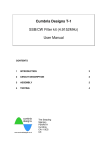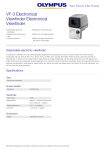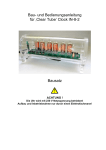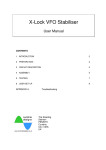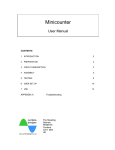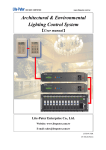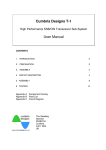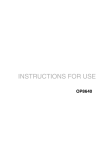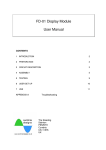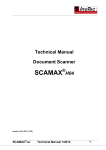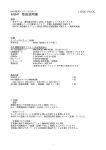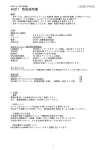Download Cumbria Designs T-1 C-1 Controller User Manual
Transcript
Cumbria Designs T-1 C-1 Controller User Manual CONTENTS 1 INTRODUCTION 2 2 CIRCUIT DESCRIPTION 2 3 ASSEMBLY 3 4 CONNECTIONS AND CONFIGURATION 4 5 TESTING 6 Appendix A C-1 Circuit Diagram and PCB Component Overlay Appendix B Parts List The Steading Stainton PENRITH Cumbria CA11 0ES UK 1 Introduction This document describes the assembly and operation of the C-1 Controller kit. Please refer to the T-1 User Manual for general information regarding component identification, placement and soldering technique. 2 Circuit Description The C-1 kit is a 16F877 based controller for the T-1 SSB/CW Transceiver Sub-System. The C-1 produces the T/R sequencing for the T-1 signal and power controls, provides Hang AGC, adjustable Full Break In CW functionality and presents user control inputs in a convenient and easily interfaced format. The C-1 connects to the T-1 by a ready assembled, 16 way ribbon cable assembly. An additional pair of wires is used to extend audio from the T-1 to the C-1 audio port for Hang AGC operation. The heart of the C-1 is the Microchip PIC16F877-A processor (IC2). This holds the firmware that interprets the user controls to produce command signals to condition the T-1 interface. PORTB of IC2 is used for control inputs. These are presented on 8 way header PL2. The controls are held high by the 10K resistor network RN1, this provides a ”stronger” reference than PORTB’s internal weak pull up resistors. The controls are activated by grounding the respective PL2 pins. Care should be taken to ensure that no potentials greater than 5V are applied to the control inputs as this may damage the processor. Four analogue inputs are presented on connectors PL3, PL4, PL5 and PL8. Of these, three are used in the first software version to support Hang AGC (PL3 and PL4) and CW Break In Delay (PL5). The fourth analogue input on PL8 is reserved for future use. Two of the three active analogue ports are used to sense the voltages set by C-1 Controller Kit potentiometers to define AGC Hang time (PL3) and Break In Delay (PL5). The third active analogue input (PL4), is an audio sampling input taken from output of the AF pre-amplifier on the T1. Three on-board trimpots allow preset adjustment of hang times associated with Hang AGC (VR1), Full Break delay (VR3) and audio input level (VR2). As an option, the on board pots VR1 and VR3 can be disabled and replaced by front panel potentiometers, connected to PL3 and PL5, by simply re-configuring the selection links JP1 and JP2. The outputs used to drive the T-1 control interface, are taken from PORTC and PORTD of the 16F877. These are extended to the 8x2 way MIL16 connector PL6. Pins 15 and 16 of PL6 are used to carry +12V from the T-1 to provide power to the C-1. In this application the optional +12V connection point on the C-1 PCB is not used. Bits 6 and 7 of PORTC are used to drive Power FETs Q1 and Q2. Both FETs are configured to provide open drain outputs on PL1 suitable for driving small relays or logic to operate power amplifier change over. Q1 is turned on when the TR sequence is changes to Transmit, Q2 when the sequence changes to Receive. Spare pins on PORTA and the 3 bit PORTE are extended on connectors PL8 and PL7 respectively to support future applications. Version 1.2 © 2005 Cumbria Designs Page 2 of 10 3 Assembly The following assembly sequence is ordered by component height. This allows the components to be held in place firmly in place when the PCB is turned over for soldering. ! 3.1 IC Socket and SIL Sockets a) Install and solder the 40 way IC socket for IC2 taking care to observe the orientation marked on the PCB. b) Using a sharp modelling knife, cut the socket strip into two 3 way lengths. Insert and solder these into positions JP1 and JP2. ! ! 3.2 SIL Resistors Insert resistor networks RN1 and RN2 taking great care to ensure correct orientation. The black dot marking pin 1 on the SIL package must align with the pin 1 marking on the PCB. Invert PCB and solder. Solder one end pin and check seating and alignment of SIL package before soldering remaining pins. 3.3 Crystal Insert the 20MHz crystal X1 and turn PCB over for soldering. The components mounted so far will ensure that a small gap exists between the crystal and the PCB. The extra lead length reduces thermal stress during soldering. Solder one lead, check position and solder second lead. 3.4 1 2 ! Ceramic Capacitors Insert and solder 22pF (22J) capacitors C10 and C11. Insert and solder 100nF (104) C1, C6, C7, C8 and C12. Note that once installed inside the 40 way IC socket, C8 is carefully folder flat against the PCB. 3.5 Power FETs Insert Q1 and Q2 in the marked positions ensuring correct orientation. Solder centre lead to hold devices in place. Check and if necessary adjust position before soldering remaining leads. 3.6 Resistors Insert resistors bend leads slightly to hold in place, solder and trim off excess leads. Tolerance band colour is given on capitals. 220R R1, R2, R8, R10 470R R9 10K R3, R4, R5, R6, R7 Red, Red, Black, Black, (BROWN) Yellow, Mauve, Black, Black, (BROWN) Brown, Black, Black, Red, (BROWN) 3.7 Variable Resistors The pre-formed leads will require to be straightened to allow the potentiometers to be inserted into the board. One at a time, insert and solder VR1, VR2 and VR3 checking seating and position after first lead is soldered and re-aligning if necessary before remaining pins are soldered. C-1 Controller Kit Version 1.2 © 2005 Cumbria Designs Page 3 of 10 ! ! 3.8 MIL-16 Header Insert the 8x2 way header in position PL7. Be sure to match orientation of header with board markings. Pin 1 of the header is marked by an arrow head on the side face of the body. This is positioned towards Q2 on the PCB such that the cut out on the connector face matches that marked on the PCB. Once positioning has been checked and ensuring that connector is fully seated, solder in place. 3.9 Electrolytic Capacitors Insert electrolytic capacitors ensuring correct orientation, solder and trim off excess leads. The negative lead is marked by a stripe on the capacitor body. The Positive lead must match the positive marking on the PCB. 10uF Electrolytic 100uF Electrolytic C3, C4, C5, C9, C12 C2 3.10 Headers Insert the header connectors with the locking tabs facing the centre of the PCB. Solder a single central pin, check alignment and seating and adjust if necessary before soldering remaining pins. 1 Way Header 3 Way Header 4 Way Header 6 Way Header 8 Way Header ! ! PL4 PL3, PL5, PL8 PL1 PL9 PL2 3.11 Regulator Insert the 5v regulator IC1, ensuring correct orientation. The underside of the metal tab should face C2 and C3. 3.11 Processor Carefully form the pins of the 16F877 processor so that they align with the holes of the 40 way IC socket. This is easily done by holding the processor on it’s side against a flat surface and applying gentle pressure to bend the pins inwards. Repeat for both sides until alignment is achieved. Take great care during insertion to ensure that all pins engage the socket and do not become bent or folded under the device. 4 Connections and Configuration 4.1 3 2 1 JP1 C6 VR1 VR2 3 2 1 JP2 VR3 Analogue Controls Selection The only configuration options on the C-1 are links JP1 and JP2 which select the on-board or external potentiometer connections for the AGC Hang Time and CW Break In Delay respectively. The links are made by forming a short length on discarded component lead into a small “U” link. The selection options are shown below. Fig. 1 Analogue Control Selection Jumpers C-1 Controller Kit Version 1.2 © 2005 Cumbria Designs Page 4 of 10 3 2 1 Pin 1 +5V Pin 2 Wiper Pin 3 Ground 10K Linear Pot Fig. 2 External Pot Connections for PL3 and PL5 Jumper 2-3 JP1 VR1 Active JP2 VR3 Active 1-2 External Input External Input Table 1 Analogue Controls Configuration The AGC Hang Time and CW Break In controls may be extended to the front panel of the host transceiver. For this option PL3 and PL5 are wired as shown. PL3 is the AGC Hang Time input, PL5 is the CW Break In Delay input. 4.2 Audio Sampling Input PL4 I used to monitor the audio from the T-1 before the AGC gain control. This signal is used by the C-1 to detect periods of silence attributable to strong AGC action with no current receive signal. When silence is detected that exceeds the AGC Hang Time setting, the C-1 switches in the fast AGC time constant to discharge the AGC capacitor and increase receiver gain. The audio sampling point can be taken from the “hot” end of the T-1 AF gain control or the AF gain connector. The wiring diagram below shows the audio being sampled from the AF gain connector. PL1 (T-1) Locking Tab PL4 (C-1) Audio Sampling Input AF Gain Pot (Rear) Fig. 3 Audio Sampling Connection 4.1 Control Inputs The functions of the PL2 Control Inputs are given in table 2. Note that these are held at +5v by pull up resistors. The functions are activated by grounding the respective input. To prevent damage to the processor, care should be taken to ensure that voltages greater than +5v are not applied to the input pins. For convenience, the AGC controls may be grouped and operated by a rotary switch to provide; AGC On/Off, AGC Fast, AGC Slow, Hang AGC. C-1 Controller Kit Version 1.2 © 2005 Cumbria Designs Page 5 of 10 PL2 Pin Number 8 7 6 5 4 3 2 1 Function High Low Mute Mode Bandwidth PTT/Key AGC AGC Speed AGC Mode USB/LSB Receiver active SSB Filter Wide (SSB) Receive AGC On AGC Fast AGC Normal USB Receiver Mute CW Filter Narrow (CW) Transmit AGC Off AGC Slow AGC Hang LSB 4.2 T-1 Interface Connection to the T-1 is made by the 16 way ribbon cable assembly. This is indexed to ensure correct orientation. The command signals on the interface are described in the T-1 manual. 4.3 Tx/Rx Auxiliary Outputs Two pairs of output signals to support operation of the host transceiver’s transmit and receive switching, are presented on PL1. Each pair comprises of a TTL level signal at zero volts for “OFF” and +5v for “ON” and an open drain power FET driven by the associated logic signal. The Power FETs are intended to drive small relays or LED indicators. A small delay is provided between the Tx and Rx signal state changes. PL1 Pin Number 1 2 3 4 Function High Low Tx TTL Output Tx FET Output Rx TTL Output Rx FET Output Transmit State Receive State Receive State Transmit State 5 Testing 5.1 Power With the C-1 connected to the T-1 via the ribbon cable power on the T-1. After about a second the T-1 should become active. If nothing happens check that the C-1 is receiving +12v over the ribbon cable and confirm that the regulator is supplying +5v to the processor. If there is power but the C-1 still doesn’t function, check the placement and soldering of the clock components X1, C9, C10 and R9. Confirm that all of the processor IC socket pins are soldered. 5.2 Functions Test the functions by consecutively grounding each of the control input pins on PL2. Confirm that the T-1 responds with the expected function. If a function cannot be enabled, check the soldering of the multiway “MIL-16” connectors on the T-1 and C-1 and verify continuity from the respective processor pin through the ribbon cable to the T-1 control circuitry. 5.3 Adjustments 5.3.1 AGC Hang Time. With the T-1 in receive and AGC on and set to Hang operation, set the C-1 Audio Level pot VR2, fully clockwise. Using either VR1 or an C-1 Controller Kit Version 1.2 © 2005 Cumbria Designs Page 6 of 10 external potentiometer connected to PL3, adjust the AGC Hang Time such that when receiving a strong signal the AGC action remains slow between words and during brief pauses in speech or CW but returns to maximum gain at the end of transmission. Turning the pot clockwise increases the delay, anticlockwise reduces the delay. With the receiver tuned to a clear frequency turn the audio level pot (VR2) anticlockwise to the threshold of frequent triggering which can be observed by monitoring the AGC Fast control output on pin 14 of the processor IC2. Advance VR2 clockwise slightly to reduce false triggering and obtain good Hang operation sensitivity when receiving a signal. 5.3.2 CW Break In Time. With CW mode selected key the PTT/Key line of the C-1 and using either VR3 or an external potentiometer connected to PL5, adjust the CW Break In Delay. Clockwise increases the delay, anticlockwise reduces the delay. The testing of the C-1 Controller is now complete. C-1 Controller Kit Version 1.2 © 2005 Cumbria Designs Page 7 of 10 Appendix A C-1 v1.0 Schematic C-1 Controller Kit Version 1.2 © 2005 Cumbria Designs Page 8 of 10 C-1 Component 0verlay Appendix B 4 1 5 1 1 3 2 4 5 1 1 2 1 1 1 1 2 3 1 1 1 1 1 2 1 1 20 1 1 PARTS LIST 220R R1, R2, R8, R10 470R R9 10K R3, R4, R5, R6, R7 SIL NETWORK 8x10K RN1 SIL NETWORK 5x10K RN2 10K TRIMPOT VR1, VR2, VR3 22pF CERAMIC C10, C11 100nF CERAMIC C1, C6, C7, C8 10uF ELECTROLYTIC C3, C4, C5, C9, C12 100uF ELETROLYTIC C2 20MHz CRYSTAL X1 2N7000 Q1, Q2 7805 IC1 PIC16F877-A IC2 40 PIN IC SOCKET 2 WAY HEADER PL4 3 WAY PINSOCKET JP1, JP2 3 WAY HEADER PL3, PL5, PL8 4 WAY HEADER PL1 6 WAY HEADER PL9 8 WAY HEADER PL2 8x2 HEADER PL7 2 WAY SHELL 3 WAY SHELL 4 WAY SHELL 8 WAY SHELL PINS 16 WAY RIBBON ASSEMBLY C-1 PCB V1.0 C-1 Controller Kit Version 1.2 © 2005 Cumbria Designs Page 9 of 10 Notes C-1 Controller Kit Version 1.2 © 2005 Cumbria Designs Page 10 of 10










